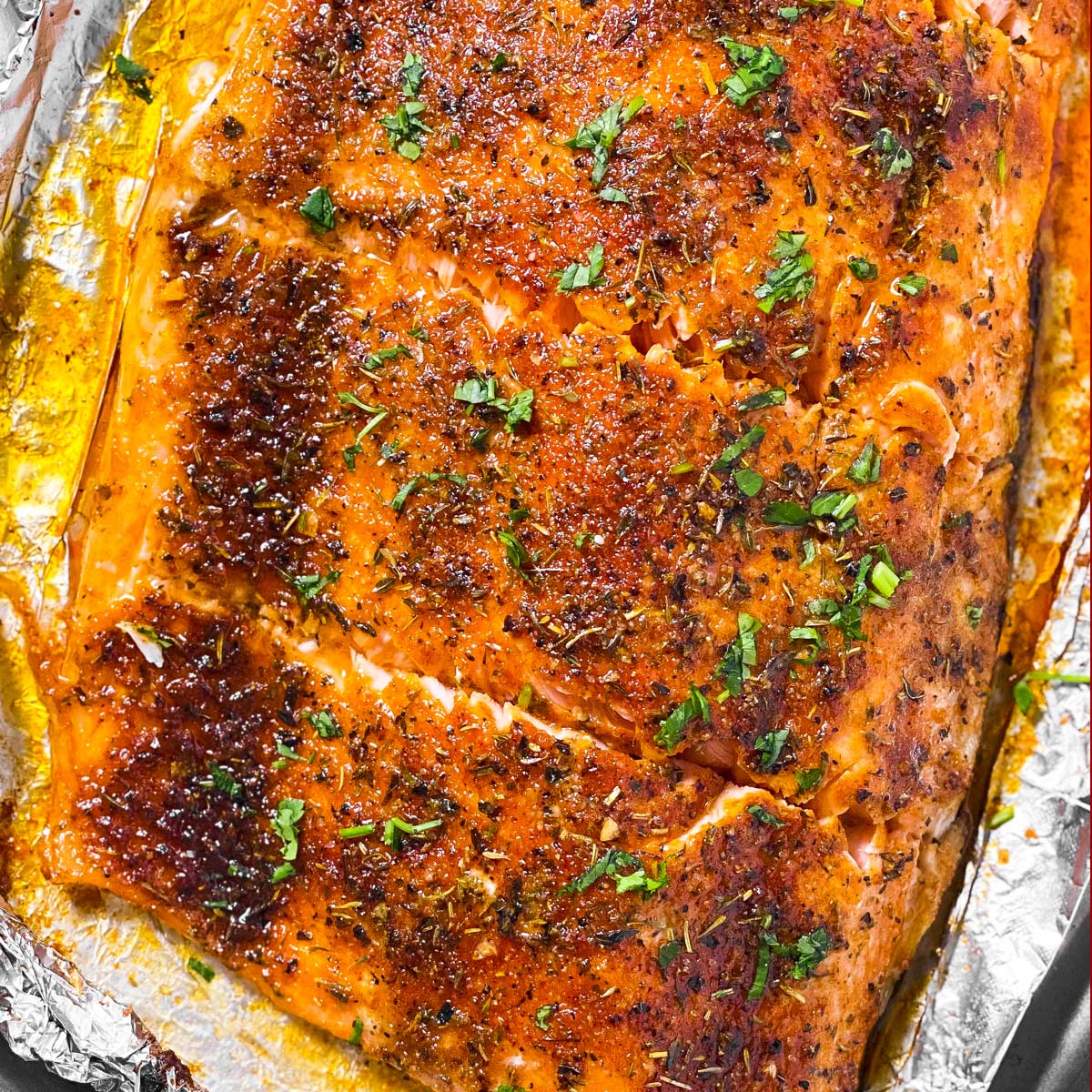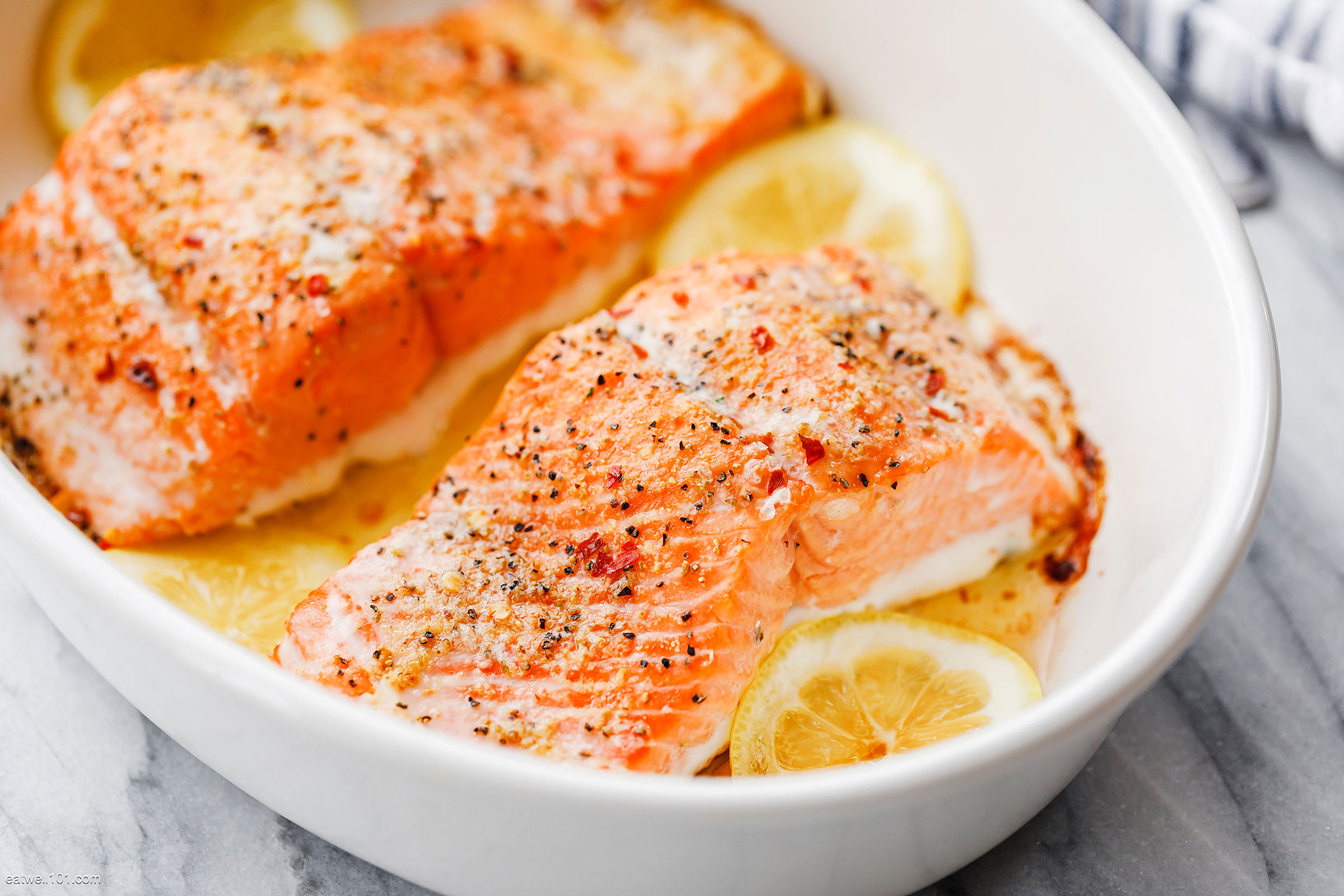Indulge in the delectable art of baking salmon, a culinary masterpiece that tantalizes taste buds and nourishes the body. From selecting the finest salmon fillets to mastering the perfect cooking techniques, this comprehensive guide will empower you to create ресторан-quality baked salmon dishes in the comfort of your own kitchen.
Prepare to embark on a culinary adventure where we explore the intricacies of seasoning, marinating, and baking salmon to achieve tender, flaky flesh and a crispy exterior. Discover the secrets of complementary side dishes and elegant presentation, transforming your baked salmon into a feast for both the eyes and the palate.
Salmon Selection and Preparation

Selecting and preparing salmon is crucial for achieving a delectable baked dish. Let’s explore the best salmon varieties, quality indicators, and techniques to ensure a perfect bake.
Types of Salmon
When choosing salmon for baking, opt for varieties known for their rich flavor and firm texture. These include:
- King salmon: Prized for its high fat content and buttery flavor.
- Sockeye salmon: A deep-red fish with a robust taste and firm flesh.
- Coho salmon: A versatile option with a medium fat content and mild flavor.
Selecting Fresh Salmon
To ensure freshness, look for salmon with the following characteristics:
- Bright, vibrant color
- Clear eyes
- Firm flesh that springs back when pressed
- Minimal odor (a slight fishy scent is acceptable)
Skin-On or Skinless Salmon
Both skin-on and skinless salmon fillets have their advantages:
- Skin-on: Provides a crispy exterior and protects the flesh from overcooking.
- Skinless: Easier to eat and reduces the fat content.
Preparing Salmon for Baking
Before baking, properly prepare the salmon to ensure even cooking and optimal flavor:
- Remove pin bones: Use a pair of tweezers or pliers to gently remove any small bones from the flesh.
- Trim excess fat: Trim away any excess fat from the edges of the fillets to prevent burning.
Seasoning and Marinade Options
Unlock the full flavor potential of baked salmon with a symphony of seasonings and marinades. Herbs, spices, citrus, and other flavorings elevate the taste, transforming ordinary fillets into culinary masterpieces.
Classic Seasonings
- Lemon-Herb: A timeless blend of lemon zest, fresh herbs like dill, parsley, or thyme, salt, and pepper.
- Garlic-Herb: A savory combination of minced garlic, dried oregano, thyme, and basil, with a hint of lemon juice.
- Dill-Mustard: A unique marinade featuring Dijon mustard, fresh dill, lemon juice, and a touch of honey for sweetness.
Innovative Marinades
- Asian-Inspired: A fusion of soy sauce, mirin, ginger, garlic, and sesame oil, creating a savory and umami-rich glaze.
- Citrus-Spice: A vibrant marinade that combines orange or grapefruit juice, lime zest, cumin, coriander, and a pinch of cayenne pepper.
- Honey-Mustard: A sweet and tangy blend of honey, Dijon mustard, brown sugar, and a dash of paprika.
To apply seasonings, simply rub them onto the salmon fillets and let them rest for at least 30 minutes. For marinades, immerse the fillets in the flavorful liquid and refrigerate for several hours or overnight. Allow excess marinade to drip off before baking to prevent sogginess.
Baking Techniques
Baking salmon is a versatile method that offers a range of textures and flavors. Whether you prefer tender, flaky flesh with a crispy exterior or moist, succulent meat, there is a baking technique to suit your preferences.
Roasting
Roasting is a classic method for baking salmon. Preheat your oven to 400-425°F (200-220°C) and line a baking sheet with foil or parchment paper. Place the salmon fillets on the prepared sheet, skin-side down. Season the salmon with your preferred herbs and spices and drizzle with olive oil.
Roast for 10-15 minutes, or until the salmon is cooked through and flakes easily with a fork.
Grilling
Grilling salmon imparts a smoky flavor and a slightly charred exterior. Preheat your grill to medium-high heat and lightly oil the grates. Place the salmon fillets on the grill, skin-side up. Grill for 4-5 minutes per side, or until the salmon is cooked through.
Broiling
Broiling results in a crispy, golden-brown exterior. Preheat your broiler to high and line a baking sheet with foil. Place the salmon fillets on the prepared sheet, skin-side up. Broil for 6-8 minutes, or until the salmon is cooked through and the exterior is browned to your desired crispiness.
Foil or Parchment Paper
Using foil or parchment paper when baking salmon helps to keep the fish moist and prevents it from sticking to the baking sheet. Foil creates a more enclosed environment, resulting in a steamed effect that can yield tender, succulent salmon.
Parchment paper allows for more air circulation, producing a crispier exterior.
Tips for Perfectly Cooked Salmon
- Choose high-quality, fresh salmon fillets.
- Season the salmon generously with herbs, spices, and olive oil.
- Use a meat thermometer to ensure the salmon is cooked to your desired doneness (145°F internal temperature for medium).
- Let the salmon rest for a few minutes before serving to allow the juices to redistribute.
Side Dish Accompaniments

Baked salmon is a versatile dish that pairs well with a variety of side dishes. Whether you prefer vegetables, grains, or salads, there are countless options to complement the rich flavor of salmon.
Nutritional Benefits
Incorporating vegetables, grains, and salads into your meal with baked salmon provides numerous nutritional benefits. Vegetables are packed with vitamins, minerals, and fiber, which support overall health and well-being. Grains provide complex carbohydrates, which are essential for energy production. Salads offer a refreshing and hydrating element to the meal, while also contributing vitamins and minerals.
Flavorful and Appealing Side Dishes
Here are a few flavorful and visually appealing side dish recipes that pair well with baked salmon:
-
-*Roasted Vegetables
Roast a medley of vegetables such as carrots, potatoes, onions, and broccoli with olive oil, salt, and pepper. The caramelized edges and tender textures will complement the salmon perfectly.
-*Quinoa Salad
Cook quinoa according to package instructions and combine it with chopped vegetables, herbs, and a tangy vinaigrette. The nutty flavor of quinoa pairs well with the richness of salmon.
-*Green Salad
Toss mixed greens with a variety of vegetables such as tomatoes, cucumbers, and bell peppers. Drizzle with a light vinaigrette or lemon juice for a refreshing and healthy side dish.
Balancing Flavors and Textures
When choosing side dishes for baked salmon, it is important to balance flavors and textures.
Roasted vegetables provide a savory and earthy element, while salads offer a lighter and refreshing contrast. Grains like quinoa or rice add a hearty and filling component to the meal. By combining different flavors and textures, you can create a well-rounded and satisfying dining experience.
Presentation and Garnishes
The presentation of your baked salmon is just as important as its flavor. A well-plated dish can make a meal look and taste even more delicious. Here are a few tips for plating baked salmon:
- Start with a clean plate. This will help the salmon stand out and make it look more appetizing.
- Place the salmon in the center of the plate. This will create a focal point and make the salmon the star of the show.
- Arrange the salmon on a bed of roasted vegetables, mashed potatoes, or rice. This will add color and texture to the dish and make it more visually appealing.
- Drizzle the salmon with a sauce or glaze. This will add flavor and moisture to the salmon and make it look more glossy.
Garnishes
Garnishes are a great way to add color, flavor, and texture to your baked salmon. Here are a few ideas for garnishes:
- Fresh herbs, such as parsley, dill, or chives
- Edible flowers, such as nasturtiums or pansies
- Lemon wedges or slices
- Capers
- Olives
- Red onion slices
When choosing garnishes, keep in mind the flavors of the salmon and the other ingredients on the plate. You want to choose garnishes that will complement the flavors of the dish and make it look more visually appealing.
Here are a few creative and visually stunning garnishes that will make your baked salmon look and taste even more delicious:
- A wreath of fresh herbs around the salmon
- A drizzle of balsamic glaze over the salmon
- A scattering of edible flowers on top of the salmon
- A few slices of lemon or lime on the side of the plate
- A dollop of crème fraîche or sour cream on the side of the plate
With a little creativity, you can easily create a baked salmon dish that is both beautiful and delicious.
Last Point
As you master the art of baking salmon, you will not only delight your family and friends with culinary creations but also reap the nutritional benefits of this omega-3-rich fish. Experiment with different flavors, techniques, and accompaniments to create your own signature baked salmon recipe.
May this guide be your constant companion on your journey towards becoming a culinary virtuoso.
Frequently Asked Questions
What is the best type of salmon for baking?
Look for wild-caught salmon varieties such as King, Sockeye, or Coho, which have a higher fat content, resulting in a more flavorful and moist baked dish.
How do I select fresh, high-quality salmon?
Choose salmon with bright, vibrant flesh that springs back when gently pressed. Avoid fillets with any signs of bruising or discoloration.
Should I use skin-on or skinless salmon fillets?
Skin-on fillets provide a crispy exterior and help retain moisture during baking. However, skinless fillets are easier to work with and may be preferred for certain recipes.
How do I properly prepare salmon for baking?
Remove any pin bones using tweezers or pliers. Trim excess fat and pat the fillets dry with paper towels to ensure even cooking and a crispy skin.
What are some classic seasoning blends for baked salmon?
Experiment with combinations of herbs such as dill, thyme, and rosemary, along with spices like paprika, garlic powder, and lemon pepper.
How do I achieve perfectly cooked salmon?
Bake the salmon at the recommended temperature and cooking time, checking for doneness by gently flaking the flesh with a fork. The internal temperature should reach 145°F (63°C) for medium-rare or 165°F (74°C) for well-done.
